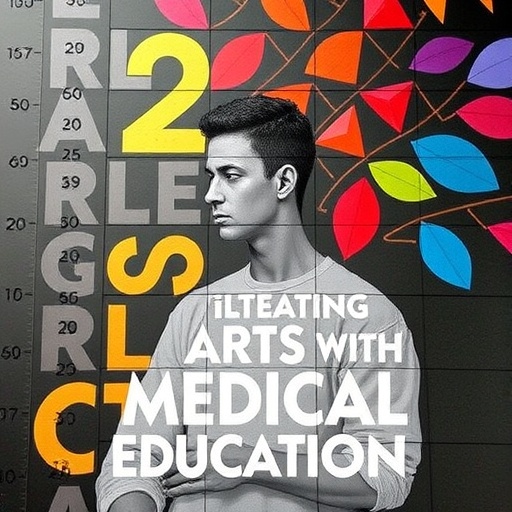In a groundbreaking study set to reshape the interface between the medical sciences and the humanities, researchers have validated a unique assessment tool known as the Art Education in Medical Education Questionnaire (AEMEQ). This innovative questionnaire aims to enlighten medical curricula with the depth and richness of artistic education, underscoring the pivotal role that humanities play in nurturing well-rounded, empathetic healthcare professionals. In the educational landscape, which has largely prioritized clinical skill acquisition and technical knowledge, this study emerges as a beacon of change, advocating for a more holistic approach to medical training.
Medical education is often criticized for being overly focused on the scientific and technical aspects of healthcare, frequently at the expense of humanity, creativity, and the aesthetic dimensions of medicine. The researchers behind the AEMEQ argue that medical professionals who engage with the arts develop a more profound understanding of patient care, enhancing their ability to connect with patients on an emotional and psychological level. Such connections not only improve patient satisfaction but also lead to better health outcomes. This perspective marks a significant shift in how medical training can and should evolve in a rapidly changing world.
The questionnaire was meticulously designed to assess various dimensions of artistic education within medical curricula, including how exposure to the arts can influence development of skills such as empathy, critical thinking, and creative problem-solving. Through their validation process, the researchers aimed to ensure that AEMEQ would stand up to rigorous academic scrutiny while providing actionable insights for medical educators looking to incorporate the humanities more extensively into their programs.
In conducting this study, the authors gathered a diverse sample of medical students and professionals, utilizing an array of analytical techniques to evaluate the questionnaire’s effectiveness. Participants provided feedback on their experiences with art education and its perceived impact on their medical training. Such a comprehensive approach not only highlights the multifaceted relationship between art and medicine but also presents compelling arguments for why medical schools should adopt a cross-disciplinary methodology.
The research outlined the various ways in which art can complement medical education. For instance, the study emphasizes that engaging in visual arts, theater, music, and literature can enhance observational skills, a vital competency in clinical practice. By fostering an appreciation for diverse perspectives, art education can teach medical professionals to recognize the unique attributes of each patient and the context of their health conditions. This understanding is essential for developing tailored treatment plans that resonate on a personal level with patients.
Moreover, exposure to the arts is posited as a means to combat burnout among healthcare professionals. The rigorous demands of medical training and practice often lead to emotional exhaustion, with many professionals facing compassion fatigue. By integrating art into the medical curriculum, students may find new outlets for stress relief and self-expression. Activities such as painting, writing, or playing music not only bring joy and relaxation but can also facilitate emotional resilience, thus promoting long-term well-being in healthcare providers.
Additionally, the study investigates the ethical dimensions that arise from the integration of arts into medical education. It confronts difficult questions related to the portrayal of illness in art and the responsibility of healthcare professionals to understand these representations. This engagement with ethical issues encourages future physicians to scrutinize the narratives surrounding health, illness, and treatment, fostering a more nuanced understanding of patient experiences.
The potential ramifications of the AEMEQ findings extend beyond the classroom and into the healthcare system at large. By cultivating a workforce that values empathy and creative thinking, patient care can evolve into a more compassionate, holistic practice. Medical humanities enthusiasts argue that the assimilation of artistic practices will provoke critical discourse, empowering healthcare professionals to challenge existing paradigms in patient engagement and public health initiatives.
Despite the compelling evidence provided by this study, integrating art education into rigid medical curricula is not without its challenges. Institutions may encounter barriers such as logistical constraints, resistance from faculty focused on traditional approaches, and inadequate resources. The authors of the study recommend strategic planning and collaboration among educators and administrators to dismantle these obstructions, advocating for the development of interdisciplinary partnerships that genuinely reflect the collective value of arts and sciences.
In conclusion, the validation of the AEMEQ signifies a pivotal moment in the evolution of medical education. By encouraging meaningful dialogue and action around the integration of the arts, the study not only contributes to academic discourse but also holds substantial transformative potential for healthcare practices. Beyond simply providing medical knowledge, enriching future physicians’ training with the humanities may very well be the key to cultivating a more understanding and thoughtfully engaged healthcare community.
As the landscape of healthcare continues to shift, adopting innovative approaches like those outlined in the AEMEQ could lead to lasting positive impacts on patient care and professional satisfaction. Stakeholders within the medical education sphere are called to consider how they can incorporate these findings into their curricula, ultimately paving the way for a generation of healthcare professionals who are as skilled in compassion and creativity as they are in clinical expertise.
Ultimately, the implications of this research transcend the boundaries of academic journals, aiming to resonate with and inspire educators, students, and medical institutions globally. The AEMEQ represents not merely a set of questions but a profound commitment to redefining the essence of medical practice itself, weaving together the threads of science and artistry in a complex tapestry of human health.
Subject of Research: Art and Humanities in Medical Education
Article Title: Validation of the art education in medical education questionnaire (AEMEQ): integrating medical sciences with the humanities
Article References:
Salmani, F., Yaghoobi, M.J., Mohammadi, Y. et al. Validation of the art education in medical education questionnaire (AEMEQ): integrating medical sciences with the humanities.
BMC Med Educ 25, 1232 (2025). https://doi.org/10.1186/s12909-025-07815-2
Image Credits: AI Generated
DOI: 10.1186/s12909-025-07815-2
Keywords: Medical education, Art education, Humanistic approach, Empathy in healthcare, Curriculum integration




